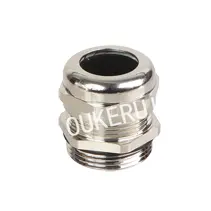Are Explosion-Proof Metal Cable Glands Necessary for Your Project
2025-08-18
When working in hazardous environments—oil rigs, chemical plants, or mining sites—the wrong Metal Cable Gland can be a safety disaster. But do you really need an explosion-proof model? Let’s break it down.
What Makes a Metal Cable Gland Explosion-Proof?
Explosion-proof Metal Cable Glands are engineered to:
-
Contain internal explosions (preventing sparks from escaping).
-
Resist extreme temperatures and pressures.
-
Maintain a seal even under duress.
OUKERUI’s explosion-proof glands meet ATEX/IECEx standards and feature:
| Feature | Benefit |
|---|---|
| Stainless Steel 316 | Corrosion-resistant, ideal for harsh conditions |
| Double-Compression Seal | Ensures no gas or dust ingress |
| Flameproof Threads | Prevents ignition from escaping sparks |
3 Key FAQs About Explosion-Proof Metal Cable Glands
1. Can I Use a Standard Metal Cable Gland in Hazardous Areas?
No. Standard glands lack flameproof sealing and certification. In zones with flammable gases or dust (Zone 1/2, Division 1/2), only ATEX/IECEx-certified glands like OUKERUI’s are legally compliant.
2. How Do Explosion-Proof Glands Differ From Weatherproof Ones?
Weatherproof glands (e.g., IP68) block water but won’t contain explosions. Explosion-proof models have reinforced construction and tested flame paths to isolate internal blasts.
3. Do Explosion-Proof Glands Require Special Maintenance?
Yes. Regularly check for:
-
Thread wear (tighten if loose).
-
Seal integrity (replace damaged O-rings).
OUKERUI’s glands include inspection guides for long-term safety.
When Are Explosion-Proof Glands Necessary?
Consider them essential for:
✔ Oil & gas facilities (flammable vapors).
✔ Grain silos (combustible dust).
✔ Chemical plants (corrosive + explosive risks).
For less volatile settings (e.g., outdoor machinery), OUKERUI’s standard Metal Cable Glands may suffice—but always verify local regulations.
Need Certified Explosion-Proof Solutions?
Don’t gamble with safety. OUKERUI’s Metal Cable Glands are rigorously tested for hazardous zones. Contact us today for expert advice—we’ll help you choose the right gland for your project’s risks.



